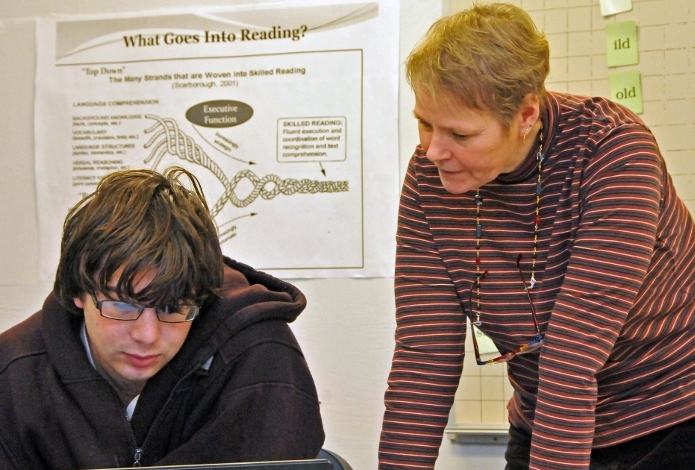Next gen college advising
A Call for Collaboration Between Disability Services and Academic Advising
by Adam R. Lalor, Ph.D. and Manju Banerjee, Ph.D.
Given the low rate of college completion for students with disabilities, it is possible that traditional student support services and accommodations may not be fully meeting their needs. Limited research on the efficacy of traditional interventions (Madaus et al., 2016) highlights the need for new and collaborative ways to engage, support, and successfully graduate these students.
Academic advising (AA) is ubiquitous in higher education. According to Light (2001), “Good advising is the single most underestimated element of a successful college experience” (para. 5). Advisors are tasked with a broad range of responsibilities, from imparting the ideals of higher education to facilitating advisees’ academic and career goal development (O’Banion, 2012). According to the NACADA, an association for academic advisors (2006), advisors assist students as they “craft a coherent educational plan based on assessment of abilities, aspirations, interests, and values” (para. 10).

Essentially, a set of courses is being selected to meet the individual needs of the students while simultaneously ensuring that the institution upholds the curricular expectations and obligations. Given the individualized and personal nature of the advisor-advisee relationship, it is not surprising that the research points to the significant impact AA can have on student retention (McArthur, 2005).
Academic advisors are particularly well positioned to serve students with disabilities because the advising process is about a plan of study towards graduation and is future-oriented (Habley et al., 2012). Conversely, Disability Services (DS) is often perceived as focused on “functional limitations” and accommodations for these limitations. Given this perceived difference between AA and DS, it is conceivable that a student would find it much easier to meet with an academic advisor than to meet with DS professional.
Generally, little direct interaction takes place between DS professionals and advisors beyond one-off professional development workshops or if there is an individual student situation that requires intervention. We believe this must change and call for greater collaboration between DS professionals and academic advisors. As such, we call for colleges and universities to adopt a model of academic advising that can be used to collect key data about student abilities. Given barriers to disability disclosure (e.g., concerns about stigma and discrimination; Hartman-Hall & Haaga, 2002), decreasing emphasis on disability documentation in the determination of accommodations (AHEAD, 2012), and the ubiquitous nature and positioning of AA, academic advising offers an optimal setting for (a) faculty sensitivity towards disability and disability awareness, (b) the provision of learning supports beyond traditional accommodations, and for (c) making referrals to appropriate campus services (e.g., DS, student services, counseling, ADA coordinator).
A hybrid model of AA (D’Alessio & Banerjee, 2016) is one approach where advisors, in partnership with DS providers, can provide valuable scaffolding and early intervention for students with disabilities. The model of advising used at Landmark College in Putney, VT, combines directive advising practices and components of academic coaching. Key elements that define this hybrid model of advising include:
- Strong advisor-advisee relationship from the start
- Continuous assessment of academic readiness
- Establishing of clear goals
- Concrete action steps
- Student self-accountability
Greater collaboration and partnership between these strategic groups within a college campus, we believe, can improve the outcomes for postsecondary students with disabilities. We encourage our colleagues in both DS and AA to forge proactive partnerships and consider ways to share resources and insight to ensure that students with disabilities are provided optimal chances for postsecondary success.
NOTE: For a more in-depth look at the hybrid model of academic advising, check out the D’Alessio and Banerjee’s (2016) article in the Journal of Postsecondary Education and Disability: https://files.eric.ed.gov/fulltext/EJ1113031.pdf
References
AHEAD. (2012). Supporting accommodation requests: Guidance on documentation practices. Retrieved from https://www.ahead.org/uploads/docs/resources/Final_AHEAD_Supporting%20Accommodation%20Requests%20with%20Q&A%2009_12.pdf
D'Alessio, K. A., and Banerjee, M. (2016). Academic Advising as an Intervention for College Students with ADHD. Journal of Postsecondary Education and Disability, 29(2), 109 – 121.
Habley, W. R., Bloom, J. L., and Robbins, S. (2012). Increasing persistence: Research-based strategies for college student success. San Francisco, CA: Jossey-Bass.
Hartman-Hall, H. M., and Haaga, D. A. (2002). College students’ willingness to seek help for their learning disabilities. Learning Disability Quarterly, 25(4), 263 – 274.
Light, R. J. (2001, March 2). The power of good advice for students. Chronicle of Higher Education, B11.
Madaus, J. W., Gelbar, N., Dukes, L. L., III, Lalor, A. R., Lombardi, A., Kowitt, J., and Faggella-Luby, M. N. (2016, September 15). Literature on postsecondary disability services: A call for research guidelines. Journal of Diversity in Higher Education. Advance online publication. http://dx.doi.org/10.1037/dhe0000045
NACADA. (2006). NACADA concept of academic advising. Retrieved from: http://www.nacada.ksu.edu/Resources/Clearinghouse/View-Articles/Concept-of-Academic-Advising-a598.aspx
O’Banion, T. (2012). Be advised. Community College Journal, 83(2), 42 – 47.